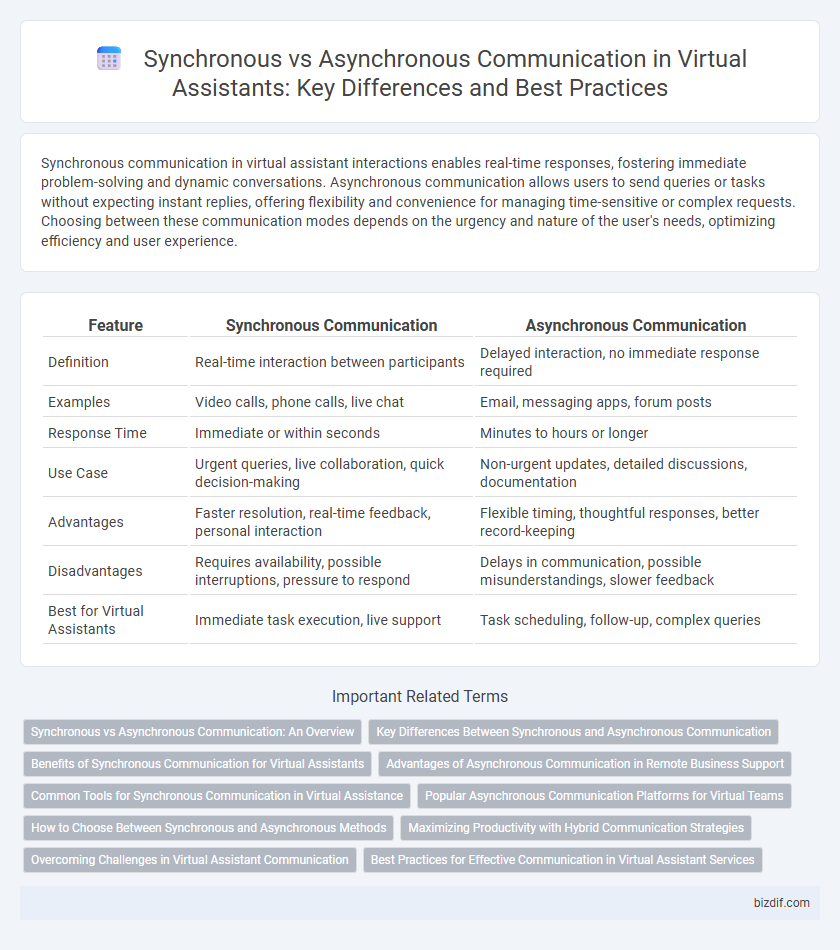Synchronous communication in virtual assistant interactions enables real-time responses, fostering immediate problem-solving and dynamic conversations. Asynchronous communication allows users to send queries or tasks without expecting instant replies, offering flexibility and convenience for managing time-sensitive or complex requests. Choosing between these communication modes depends on the urgency and nature of the user's needs, optimizing efficiency and user experience.
Table of Comparison
| Feature | Synchronous Communication | Asynchronous Communication |
|---|---|---|
| Definition | Real-time interaction between participants | Delayed interaction, no immediate response required |
| Examples | Video calls, phone calls, live chat | Email, messaging apps, forum posts |
| Response Time | Immediate or within seconds | Minutes to hours or longer |
| Use Case | Urgent queries, live collaboration, quick decision-making | Non-urgent updates, detailed discussions, documentation |
| Advantages | Faster resolution, real-time feedback, personal interaction | Flexible timing, thoughtful responses, better record-keeping |
| Disadvantages | Requires availability, possible interruptions, pressure to respond | Delays in communication, possible misunderstandings, slower feedback |
| Best for Virtual Assistants | Immediate task execution, live support | Task scheduling, follow-up, complex queries |
Synchronous vs Asynchronous Communication: An Overview
Synchronous communication occurs in real-time, enabling immediate interactions through channels like video calls, instant messaging, or phone conversations. Asynchronous communication allows messages to be sent and received at different times, using methods such as email, voice recordings, or collaboration platforms. Choosing between synchronous and asynchronous communication depends on factors like urgency, availability, and the need for instant feedback in virtual assistant environments.
Key Differences Between Synchronous and Asynchronous Communication
Synchronous communication occurs in real-time, requiring all participants to engage simultaneously, such as in phone calls or live video chats, enabling immediate feedback and interaction. Asynchronous communication allows individuals to respond at their convenience through emails or messaging platforms, promoting flexibility and reducing the pressure of instant replies. Key differences include timing, interaction pace, and suitability for urgent versus non-urgent information exchange in virtual assistant workflows.
Benefits of Synchronous Communication for Virtual Assistants
Synchronous communication enables virtual assistants to provide immediate responses and real-time support, enhancing user experience and engagement. It facilitates clearer understanding through instant feedback and clarification, reducing miscommunication and errors. This type of communication is crucial for handling urgent tasks and complex queries that require prompt attention and interaction.
Advantages of Asynchronous Communication in Remote Business Support
Asynchronous communication enhances remote business support by allowing team members to respond at their convenience, increasing productivity and reducing the pressure of immediate replies. It supports detailed and thoughtful responses, improving the accuracy and quality of information exchanged. This flexibility also accommodates different time zones, fostering seamless collaboration across global remote teams.
Common Tools for Synchronous Communication in Virtual Assistance
Common tools for synchronous communication in virtual assistance include video conferencing platforms like Zoom and Microsoft Teams, which enable real-time face-to-face interaction and efficient collaboration. Instant messaging apps such as Slack and Google Chat facilitate immediate text-based conversations, quick decision-making, and instant feedback. These tools are essential for maintaining timely communication, enhancing team coordination, and providing prompt support to clients or colleagues.
Popular Asynchronous Communication Platforms for Virtual Teams
Popular asynchronous communication platforms for virtual teams include Slack, Microsoft Teams, and Trello, which enable seamless collaboration without the need for simultaneous participation. These tools support message threading, file sharing, and task management, allowing team members to respond at their convenience. Asynchronous communication enhances productivity by reducing interruptions and accommodating diverse time zones.
How to Choose Between Synchronous and Asynchronous Methods
Choosing between synchronous and asynchronous communication depends on task urgency and collaboration needs; synchronous methods like video calls enable real-time interaction essential for immediate feedback, while asynchronous channels such as emails allow flexibility and thoughtful responses across different time zones. Evaluate team availability, project complexity, and communication goals to decide whether instant dialogue or delayed, reflective exchanges enhance productivity. Incorporating virtual assistants can streamline both methods by managing schedules for synchronous meetings or organizing asynchronous information flow efficiently.
Maximizing Productivity with Hybrid Communication Strategies
Synchronous communication, such as real-time chats and video calls, enables immediate feedback and dynamic collaboration, essential for urgent decision-making and brainstorming sessions. Asynchronous communication, including emails and project management tools, allows team members to respond at their own pace, enhancing focus and reducing interruptions. Combining both methods in hybrid communication strategies maximizes productivity by balancing prompt interaction with thoughtful, flexible task management.
Overcoming Challenges in Virtual Assistant Communication
Overcoming challenges in virtual assistant communication requires balancing synchronous communication, such as real-time chats or video calls, with asynchronous methods like emails or messaging apps to ensure flexibility and responsiveness. Synchronous communication enhances immediate problem-solving and clarifications, while asynchronous communication supports thoughtful, uninterrupted workflows and accommodates different time zones. Effective virtual assistant systems leverage a hybrid model to optimize productivity, reduce misunderstandings, and maintain continuous collaboration.
Best Practices for Effective Communication in Virtual Assistant Services
Synchronous communication in virtual assistant services involves real-time interactions, such as live chats and video calls, facilitating immediate feedback and quicker decision-making. Asynchronous communication, including emails and task management tools, allows flexible responses and better documentation, supporting productivity across diverse time zones. Best practices include clearly setting availability expectations, prioritizing urgent synchronous engagements, and leveraging asynchronous methods for detailed, non-urgent tasks to optimize workflow efficiency and client satisfaction.
Synchronous communication vs Asynchronous communication Infographic

 bizdif.com
bizdif.com